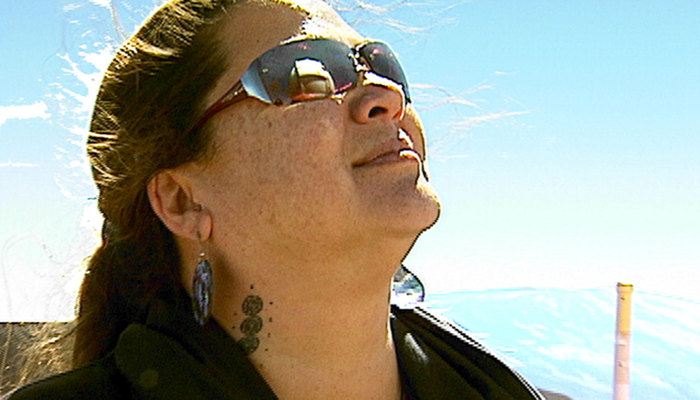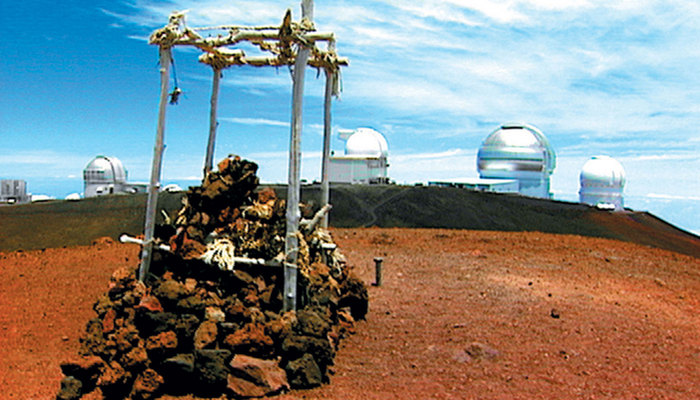
Mauna Kea: Temple Under Siege
The struggle between the scientific and Native Hawaiian communities.
- Filmmaker(s)
- Joan Lander
- Puhipau
- Category
- Full-Length Film
- Subject Matter
- Culture, Politics & Government, Culture Democracy & Rights
- Featured In
- 25 in 25
- Region
- Polynesia
- Length
- 60 Minutes
- Year
- 2006
- Website
- www.hawaiianvoice.com
Although the volcano Mauna Kea last erupted around 4,000 years ago, it is still hot today. The mountain is the center of a burning controversy over whether its summit should be used for astronomical observatories or preserved as a cultural landscape sacred to the Hawaiian people. This issue is explored in Mauna Kea: Temple Under Siege.
Mauna Kea: Temple Under Siege was six years in the making as Hawai'i island-based filmmakers, Joan Lander and Puhipau, captured on video the story of a mountain that has been the focus of international attention for the past 30 years.Na Maka o ka ‘Aina ("The Eyes of the Land") is an independent video production team that focuses on the land and the people of Hawai'i and the Pacific. Documenting traditional and contemporary Hawaiian culture, politics, history, language, and the environment, Na Maka o ka ‘Aina is committed to giving voice to the current movement toward recognition of Hawaiian independence.
Na Maka o ka ‘Aina's video catalog description
About the Producer
Since 1982, Na Maka o ka ‘Aina has aired over 80 programs on Hawai'i Public Television, the Public Broadcasting Service, Deep Dish satellite network, Free Speech TV, and Hawaii's commercial stations, in addition to producing regular programming for Hawaii's public access cable channels. Their work airs in Australia, ‘Aotearoa (New Zealand), Denmark, Canada (Aboriginal Peoples Television Network), and Japan.
More About the Film
"It's a perfect example of clashing cosmologies," says Manulani Aluli Meyer, Hawaiian philosopher of education, referring to the competing interests on Mauna Kea's summit. Regarded by the international astronomy community as the best place on Earth to observe the stars, the mountaintop is one of the most developed peaks in the world, hosting 13 telescopes and multiple antenna arrays.
"But for Hawaiians who live in its shadow, Mauna Kea is the first born of cosmic forces, connecting us with our ancestors from the beginning of time," says co-producer Puhipau. "It’s a place of strong mana (power) and the most significant of our Hawaiian Kingdom lands, now under occupation by the United States and the State of Hawai‘i."
The documentary captures the seasonal moods, snowstorms, and mists of Mauna Kea's unique 14,000-foot summit environment and the richly varied and endangered natural ecosystems that extend from sea level to alpine zone. Legends of Hawaiian deities, such as volcano goddess Pele and snow goddess Poli'ahu, reveal the mountain's geologic history of eruptions and glaciers.
Woven throughout the program is the story of the political turbulence surrounding efforts to protect the most significant temple in the islands, the mountain itself. Yet, indigenous Hawaiians are not the only native people dealing with this issue—the Apache of Arizona are also struggling to protect their sacred mountain, Dzil Nchaa Si An, also known as Mt. Graham. Ola Cassadore Davis and Mike Davis from the Apache Survival Coalition are facing the same reality of telescope development that affect Native Hawaiians. This film captures a bond of commonality that connects indigenous peoples in the struggle for cultural preservation and free religious expression.




